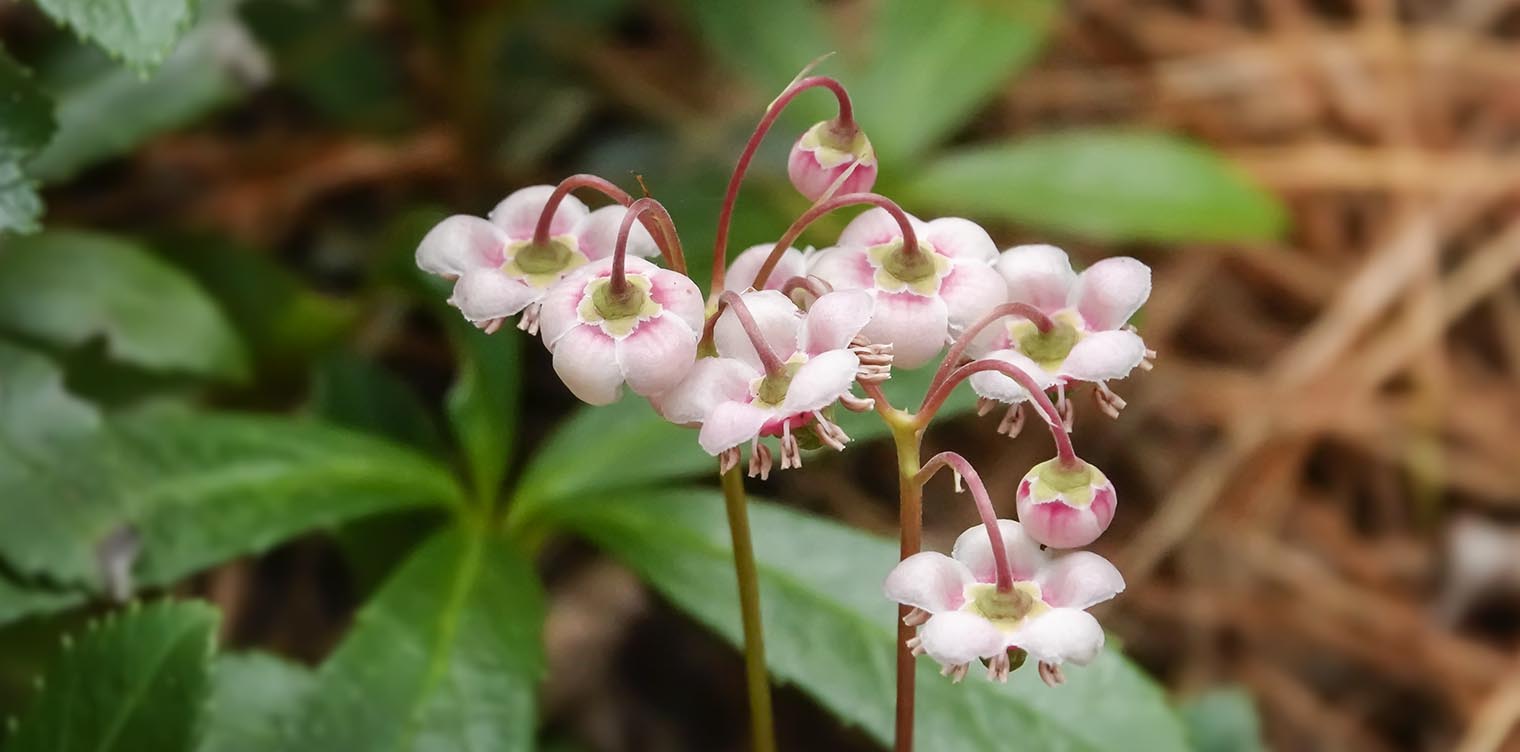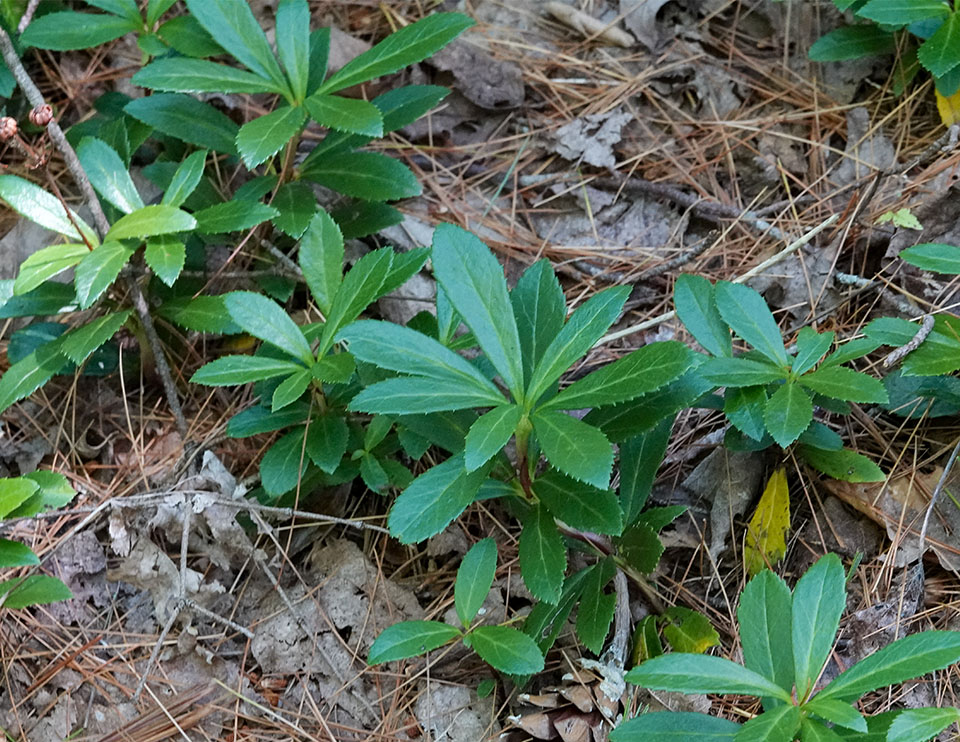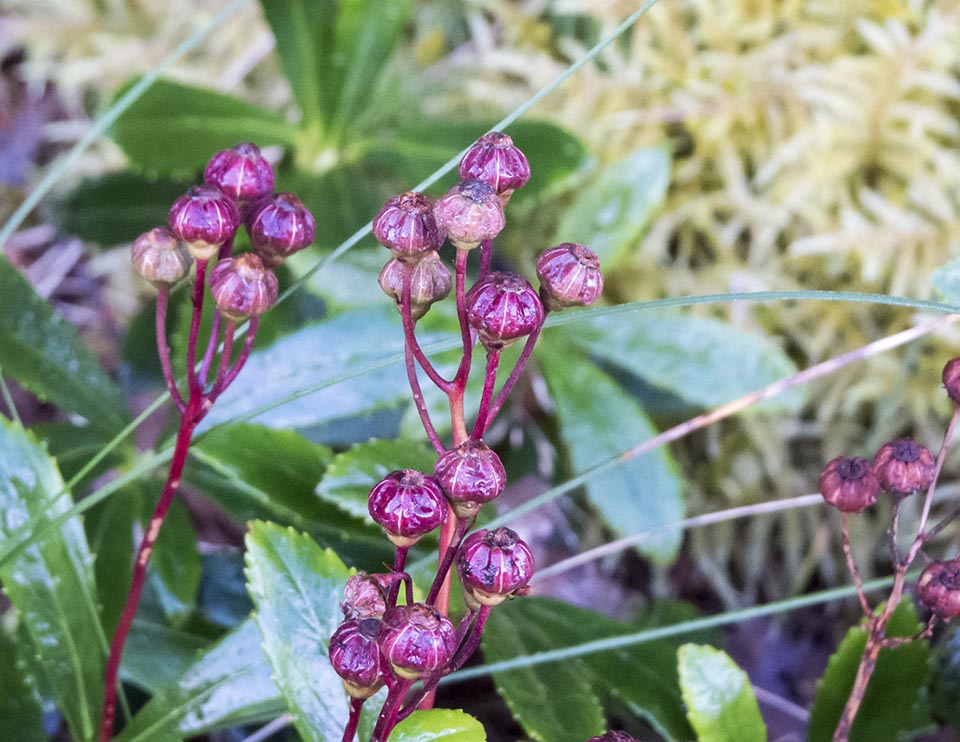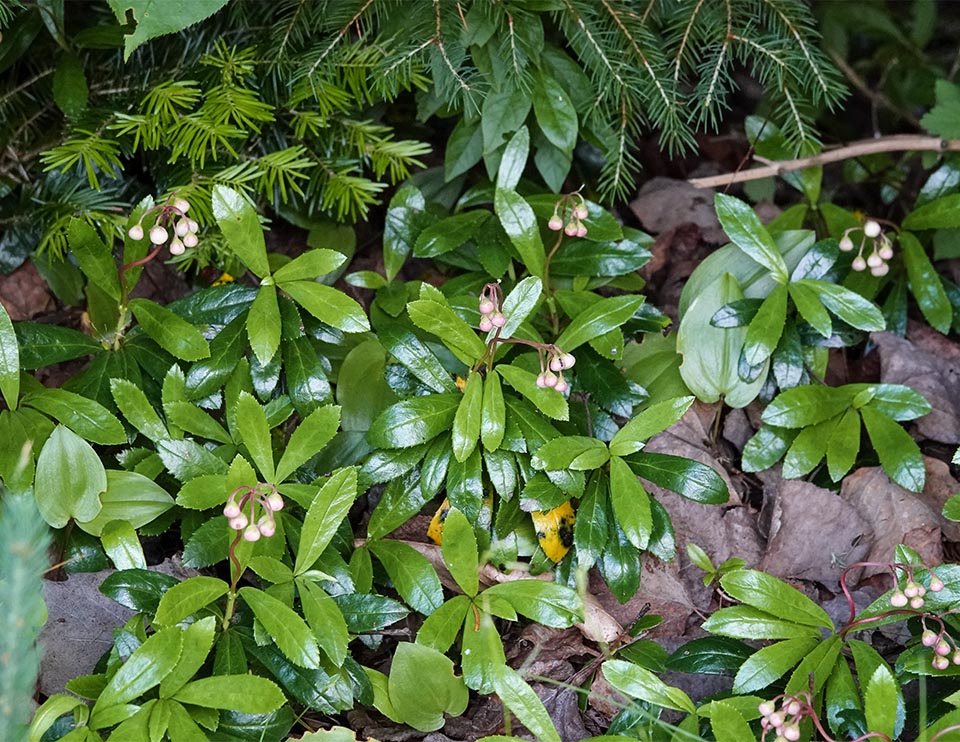Wildflowers of the Adirondacks:
Pipsissewa (Chimaphila umbellata)

Pipsissewa (Chimaphila umbellata) is a native Adirondack wildflower which produces a cluster of pink or white flowers in July, followed by colorful deep pink fruit capsules in August and September. Pipsissewa is also known as Prince's Pine. It is a member of the Pyrola family. Other common names for Pipsissewa include Waxflower, Common Pipsissewa, Noble Prince's-Pine, and Bitter Wintergreen.
The name Chimaphila is from the Greek cheima, meaning "winter weather" – a reference to the fact that the plant is evergreen, with leaves persisting through winter.
Identification of Pipsissewa

Pipsissewa is an evergreen plant classified as a subshrub. It grows four to ten inches high. The erect stems are slender and woody. Each year's growth puts out a few new branches, which eventually root and form mats.
The lance-shaped evergreen leaves of Pipsissewa are dark green and glossy. The leaves are one to two inches long and about a half inch wide; they are whorled with distinct sharp teeth along the edges.
Pipsissewa flowers are pink to red or white, growing in a loose terminal cluster of three to seven nodding flowers. The flowers are about ½ inch long, with five thick waxy petals. The petals are cup-shaped, with rounded tips. The flowers are borne on slender stalks standing well above the upper leaves. The petals are arrayed around a plump green central pistil, which is also surrounded by a ring of reddish anthers. In the Adirondack Mountains, Pipsissewa usually starts to bud in early July, with flowers blooming for most of the month.

Pipsissewa flowers are followed by fruit in the form of a small, five-sectioned capsule. The fruit capsule starts off green, then changes to a deep pink. In late fall, it darkens to brown and splits open to expose the seeds. The capsules are about ¼ inch in diameter, with a distinct button-shaped cap. In the Adirondacks, Pipsissewa is in fruit from early August through late October.
Uses of Pipsissewa
Pipsissewa has several edible uses. The leaves of the Pipsissewa plant reportedly can be made into a tea or used as flavoring in root beer. The leaves have also been used to flavor candy and soft drinks.
In addition, Pipsissewa played an important medicinal role among North American Indians and settlers. It reportedly was used by many tribes to treat a wide variety of aliments, including fevers, colds, kidney stones, skin diseases, stomach ailments, chest pains, and chronic rheumatism. The plant was reportedly also used by some native Americans for backache.
Wildlife Value of Pipsissewa

No wildlife uses of this species were found for the Adirondack region.
Distribution of Pipsissewa
Pipsissewa is a circumboreal species that is widely distributed in the northern hemisphere. It can be found from Newfoundland to Alaska, south to California. The plant also grows in the eastern United States, from Maine south in the mountains to Georgia and west to Minnesota. Pipsissewa is listed as endangered in Illinois, threatened in Iowa and Ohio, and exploitably vulnerable in New York State.
Pipsissewa is found in almost all counties in New York State, including all counties within the Adirondack Park Blue Line except Herkimer County. This plant is protected under the 1974 New York State Wildflower Law.
Habitat of Pipsissewa
In the Adirondack Mountains, Pipsissewa grows in well-drained mixed or coniferous woods, usually in light shade. It can be found in dry sandy forests, on the edges of forests, and along roadsides. Pipsissewa usually grows in small patches.
References
Michael Kudish. Adirondack Upland Flora: An Ecological Perspective (The Chauncy Press, 1992), pp. 146, 242.
New York Flora Association. New York Flora Atlas. Pipsissewa. Chimaphila umbellata. Retrieved 26 August 2017.
United States Department of Agriculture. The Plants Database. Pipsissewa. Chimaphila umbellata (L.) W.P.C. Barton. Retrieved 26 August 2017.
United States Department of Agriculture. Fire Effects Information System (FEIS). Species Reviews. Chimaphila umbellata. Retrieved 26 August 2017.
Flora of North America. Chimaphila umbellata. Retrieved 26 August 2017.
Northern Forest Atlas. Images. Pipsissewa. Chimaphila umbellata. Retrieved 6 July 2021.
Native Plant Trust. Go Botany. Pipsissewa. Chimaphila umbellata. Retrieved 6 July 2021.
iNaturalist. Pipsissewa. Chimaphila umbellata. Retrieved 6 July 2021.
iNaturalist. Adirondack Park Observations. Pipsissewa. Chimaphila umbellata. Retrieved 6 July 2021.
New York State. Adirondack Park Agency. Preliminary List of Species Native Within the Adirondack Park Listed Alphabetically by Scientific Name and Sorted by Habit. Volume 1. Updated 10.23.2006, p. 18. Retrieved 26 January 2017.
USA National Phenology Network. Nature’s Notebook. Chimaphila umbellata. Retrieved 7 May 2017.
Connecticut Botanical Society. Pipsissewa (Prince's Pine). Chimaphila umbellata. Retrieved 26 August 2017.
University of Wisconsin. Flora of Wisconsin. Chimaphila umbellata. Retrieved 6 July 2021.
Minnesota Wildflowers. Chimaphila umbellata. Pipsissewa. Retrieved 26 August 2017.
Lady Bird Johnson Wildflower Center. Chimaphila umbellata. Retrieved 26 August 2017.
Anne McGrath. Wildflowers of the Adirondacks (EarthWords, 2000), p. 21, Plate 10.
Roger Tory Peterson and Margaret McKenny. A Field Guide to Wildflowers. Northeastern and North-central North America (Houghton Mifflin Company, 1968), pp. 234-235 .
Doug Ladd. North Woods Wildflowers (Falcon Publishing, 2001), p. 94.
Lawrence Newcomb. Newcomb's Wildflower Guide (Little Brown and Company, 1977), pp. 284-285.
John Kricher. A Field Guide to Eastern Forests. North America (Houghton Mifflin, 1998), pp. 109, 325.
National Audubon Society. Field Guide to North American Wildflowers. Eastern Region. (Alfred A. Knopf, 2001), p. 718.
William K. Chapman et al., Wildflowers of New York in Color (Syracuse University Press, 1998), pp. 22-23.
Plants for a Future. Chimaphila umbellata. Retrieved 6 July 2021.
Steven Foster and James A. Duke. Medicinal Plants and Herbs of Eastern and Central North America (Houghton Mifflin Harcourt, 2014), pp. 50-51.
University of Michigan. Native American Ethnobotany. A Database of Foods, Drugs, Dyes and Fibers of Native American Peoples, Derived from Plants. Chimaphila umbellata. Retrieved 26 October 2017.
Charles H. Peck. Plants of North Elba (Bulletin of the New York State Museum, Volume 6, Number 28, June 1899). Retrieved 22 February 2017, p. 113.
